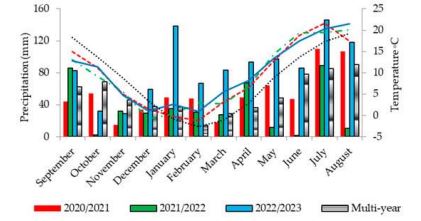Nitrogen Fertilization Strategies for Sustainable Winter Wheat Production in a Growing World
Keywords:
Arable Land, Nitrogen Deficiency, Susceptibility to Diseases, Effective Nitrogen ManagementAbstract
The escalating global human population, projected to reach nine billion by 2050, necessitates proactive measures to address the impending food gap. Crop yield augmentation and the expansion of arable land emerge as primary strategies to ensure food security. Winter wheat, a vital cereal crop, holds the potential to bridge this gap. However, global wheat yield averages remain suboptimal, emphasizing the underexplored potential of this critical crop. Nitrogen, a pivotal nutrient for wheat, significantly influences grain yield and quality. Efficient nitrogen management is crucial for maximizing profitability while minimizing environmental impact. Nitrogen deficiency poses limitations to winter wheat production, impacting growth and yield positively, while excess nitrogen leads to undesirable consequences such as lodging and susceptibility to diseases. Despite its potential, a decline in winter wheat grain production in 2021 underscores the need to evaluate the role of nitrogen fertilizers in enhancing production sustainability. Encouraging farmers to judiciously apply nitrogen fertilizers emerges as a key strategy to enhance winter wheat sustainability, supported by a three-year study conducted by the State Agricultural University. China, as the world's largest wheat-producing country, also emphasizes the importance of nitrogen fertilization in optimizing yields. However, excessive nitrogen application poses environmental risks and requires careful consideration to balance crop productivity and environmental sustainability. This comprehensive review highlights the intricate relationship between nitrogen fertilization and winter wheat productivity, considering factors such as planting dates, nitrogen rates, and environmental conditions. The research underscores the need for optimal nitrogen application to enhance grain yield while minimizing environmental impact. The study's results, drawn from multiple sources and field experiments, demonstrate that nitrogen fertilization plays a crucial role in winter wheat growth and development. The findings emphasize the importance of considering specific factors such as nitrogen dosage, planting dates, and regional conditions for effective nitrogen management. Overall, this research provides valuable insights into the multifaceted impact of nitrogen fertilization on winter wheat, offering guidance for sustainable agricultural practices to ensure food security and environmental preservation.
References
C. Fabbri, B. Basso, M. Napoli, A. Dalla Marta, S. Orlandini, and R. A. Martinez-Feria, “Developing a tactical nitrogen fertilizer management strategy for sustainable wheat production,” Eur. J. Agron., vol. 144, p. 126746, Mar. 2023, doi: 10.1016/J.EJA.2023.126746.
T. M. Addiscott and D. S. Powlson, “Partitioning losses of nitrogen fertilizer between leaching and denitrification,” J. Agric. Sci., vol. 118, no. 1, pp. 101–107, 1992, doi: 10.1017/S0021859600068052.
G. Agegnehu, C. vanbeek, and M. I. Bird, “Influence of integrated soil fertility management in wheat and tef productivity and soil chemical properties in the highland tropical environment,” J. Soil Sci. Plant Nutr., vol. 14, no. 3, pp. 532–545, Sep. 2014, doi: 10.4067/S0718-95162014005000042.
K. Akhtar et al., “Straw mulching with inorganic nitrogen fertilizer reduces soil CO2 and N2O emissions and improves wheat yield,” Sci. Total Environ., vol. 741, Nov. 2020, doi: 10.1016/j.scitotenv.2020.140488.
S. M. Albarenque, B. Basso, O. P. Caviglia, and R. J. M. Melchiori, “Spatio-temporal nitrogen fertilizer response in maize: Field study and modeling approach,” Agron. J., vol. 108, no. 5, pp. 2110–2122, Sep. 2016, doi: 10.2134/AGRONJ2016.02.0081.
D. A. Baker, D. L. Young, D. R. Huggins, and W. L. Pan, “Economically Optimal Nitrogen Fertilization for Yield and Protein in Hard Red Spring Wheat,” Agron. J., vol. 96, no. 1, pp. 116–123, Jan. 2004, doi: 10.2134/AGRONJ2004.1160.
S. Asseng et al., “Performance of the APSIM-wheat model in Western Australia,” F. Crop. Res., vol. 57, no. 2, pp. 163–179, May 1998, doi: 10.1016/S0378-4290(97)00117-2.
B. Basso and J. T. Ritchie, “Impact of compost, manure and inorganic fertilizer on nitrate leaching and yield for a 6-year maize-alfalfa rotation in Michigan,” Agric. Ecosyst. Environ., vol. 108, no. 4, pp. 329–341, Jul. 2005, doi: 10.1016/j.agee.2005.01.011.
B. Basso, J. T. Ritchie, P. R. Grace, and L. Sartori, “Simulation of Tillage Systems Impact on Soil Biophysical Properties Using the SALUS Model,” Ital. J. Agron., vol. 1, no. 4, p. 677, Dec. 2006, doi: 10.4081/IJA.2006.677.
B. Basso, J. T. Ritchie, D. Cammarano, and L. Sartori, “A strategic and tactical management approach to select optimal N fertilizer rates for wheat in a spatially variable field,” Eur. J. Agron., vol. 35, no. 4, pp. 215–222, Nov. 2011, doi: 10.1016/j.eja.2011.06.004.
B. Basso, D. Cammarano, A. Troccoli, D. Chen, and J. T. Ritchie, “Long-term wheat response to nitrogen in a rainfed Mediterranean environment: Field data and simulation analysis,” Eur. J. Agron., vol. 33, no. 2, pp. 132–138, Aug. 2010, doi: 10.1016/j.eja.2010.04.004.
B. Basso, G. Shuai, J. Zhang, and G. P. Robertson, “Yield stability analysis reveals sources of large-scale nitrogen loss from the US Midwest,” Sci. Rep., vol. 9, no. 1, Dec. 2019, doi: 10.1038/S41598-019-42271-1.
D. Beillouin et al., “Azodyn-Barley, a winter-barley crop model for predicting and ranking genotypic yield, grain protein and grain size in contrasting pedoclimatic conditions,” Agric. For. Meteorol., vol. 262, pp. 237–248, Nov. 2018, doi: 10.1016/j.agrformet.2018.06.002.
J. M. Beman, K. R. Arrigo, and P. A. Matson, “Agricultural runoff fuels large phytoplankton blooms in vulnerable areas of the ocean,” Nature, vol. 434, no. 7030, pp. 211–214, Mar. 2005, doi: 10.1038/NATURE03370.
A. Madias, L. Borrás, and B. L. Gambin, “Foliar fungicides help maize farmers reduce yield gaps in late sown crops in a temperate region,” Eur. J. Agron., vol. 145, Apr. 2023, doi: 10.1016/j.eja.2023.126768.
“Developing a tactical nitrogen fertilizer management strategy for sustainable wheat production - ScienceDirect.” Accessed: Feb. 18, 2024. [Online]. Available: https://www.sciencedirect.com/science/article/pii/S116103012300014X
H. Song, M. Asghari, P. Zahedipour-Sheshglani, M. Alizadeh, S. Qian, and E. Diao, “Modeling and optimizing the effects of Trichoderma on quality, decay extension rate and phytochemical compounds of Thompson seedless table grapes by the use of response surface methodology,” Eur. J. Agron., vol. 144, Mar. 2023, doi: 10.1016/j.eja.2023.126758.
M. Shu, K. Bai, L. Meng, X. Yang, B. Li, and Y. Ma, “Assessing maize lodging severity using multitemporal UAV-based digital images,” Eur. J. Agron., vol. 144, Mar. 2023, doi: 10.1016/j.eja.2023.126754.
“(PDF) Response of Winter Wheat to Delayed Sowing and Varied Nitrogen Fertilization.” Accessed: Feb. 18, 2024. [Online]. Available: https://www.researchgate.net/publication/377419665_Response_of_Winter_Wheat_to_Delayed_Sowing_and_Varied_Nitrogen_Fertilization
B. J. Bohman et al., “Quantifying critical N dilution curves across G × E × M effects for potato using a partially-pooled Bayesian hierarchical method,” Eur. J. Agron., vol. 144, Mar. 2023, doi: 10.1016/j.eja.2023.126744.
R. Gafni, G. A. Ziv, H. Eizenberg, and L. Blank, “A regional-scale study of the contribution of local, management and climate factors to the infestation of processing tomato fields with Amaranthus species,” Eur. J. Agron., vol. 143, Feb. 2023, doi: 10.1016/j.eja.2022.126722.
A. A. Chandio, K. K. Gokmenoglu, N. Sethi, D. Ozdemir, and Y. Jiang, “Examining the impacts of technological advancement on cereal production in ASEAN countries: Does information and communication technology matter?,” Eur. J. Agron., vol. 144, Mar. 2023, doi: 10.1016/j.eja.2023.126747.
M. Mancini, L. Guerrini, C. Fabbri, S. Orlandini, and M. Napoli, “Understanding the impact of within-field Olsen P variation on common wheat production in Olsen P deficient soils,” J. Agric. Food Res., vol. 15, Mar. 2024, doi: 10.1016/j.jafr.2024.101007.
J. Hett, T. F. Döring, A. Bevivino, and D. Neuhoff, “Impact of microbial consortia on organic maize in a temperate climate varies with environment but not with fertilization,” Eur. J. Agron., vol. 144, Mar. 2023, doi: 10.1016/j.eja.2023.126743.
L. H. Moro Rosso, A. F. de Borja Reis, S. Tamagno, A. A. Correndo, P. V. V. Prasad, and I. A. Ciampitti, “Temporal variation of soil N supply defines N fixation in soybeans,” Eur. J. Agron., vol. 144, Mar. 2023, doi: 10.1016/j.eja.2023.126745.
Y. Zhu, W. Li, Q. Jing, W. Cao, and T. Horie, “Modeling grain protein formation in relation to nitrogen uptake and remobilization in rice plant,” Front. Agric. China, vol. 1, no. 1, pp. 8–16, Feb. 2007, doi: 10.1007/S11703-007-0002-2.
I. N. Xynias et al., “Durum wheat breeding in the Mediterranean region: Current status and future prospects,” Agronomy, vol. 10, no. 3, 2020, doi: 10.3390/AGRONOMY10030432.
D. Zhang et al., “DSSAT-CERES-Wheat model to optimize plant density and nitrogen best management practices,” Nutr. Cycl. Agroecosystems, 2019, doi: 10.1007/S10705-019-09984-1.
N. Tremblay and C. Bélec, “Adapting nitrogen fertilization to unpredictable seasonal conditions with the least impact on the environment,” Horttechnology, vol. 16, no. 3, pp. 408–412, 2006, doi: 10.21273/HORTTECH.16.3.0408.
G. V. Subbarao et al., “Genetic mitigation strategies to tackle agricultural GHG emissions: The case for biological nitrification inhibition technology,” Plant Sci., vol. 262, pp. 165–168, Sep. 2017, doi: 10.1016/j.plantsci.2017.05.004.
S. Sela, H. M. van Es, B. N. Moebius-Clune, R. Marjerison, and G. Kneubuhler, “Dynamic model-based recommendations increase the precision and sustainability of N fertilization in midwestern US maize production,” Comput. Electron. Agric., vol. 153, pp. 256–265, Oct. 2018, doi: 10.1016/J.COMPAG.2018.08.010.
Q. Soofizada et al., “Effects of Nitrogen plus Sulfur Fertilization and Seeding Density on Yield, Rheological Parameters, and Asparagine Content in Old Varieties of Common Wheat (Triticum aestivum L.),” Agronomy, vol. 12, no. 2, Feb. 2022, doi: 10.3390/AGRONOMY12020351.
M. Stapper and H. C. Harris, “Assessing the productivity of wheat genotypes in a Mediterranean climate, using a crop-simulation model,” F. Crop. Res., vol. 20, no. 2, pp. 129–152, 1989, doi: 10.1016/0378-4290(89)90057-9.
S. Pampana, A. Masoni, L. Ercoli, M. Mariotti, and I. Arduini, “Effects of nitrogen splitting and source on durum wheat,” Cereal Res. Commun., vol. 41, no. 2, pp. 338–347, Jun. 2013, doi: 10.1556/CRC.2013.0003.
A. Pezzuolo, B. Basso, F. Marinello, and L. Sartori, “Using SALUS model for medium and long term simulations of energy efficiency in different tillage systems,” Appl. Math. Sci., vol. 8, no. 129–132, pp. 6433–6445, 2014, doi: 10.12988/AMS.2014.46447.
G. J. O’Leary and D. J. Connor, “A simulation model of the wheat crop in response to water and nitrogen supply: II. Model validation,” Agric. Syst., vol. 52, no. 1, pp. 31–55, 1996, doi: 10.1016/0308-521X(96)00002-9.
J. I. Ortiz-Monasterio and W. Raun, “Paper presented at international workshop on increasing wheat yield potential, CIMMYT, Obregon, Mexico, 20-24 March 2006: Reduced nitrogen and improved farm income for irrigated spring wheat in the Yaqui Valley, Mexico, using sensor based nitrogen management,” J. Agric. Sci., vol. 145, no. 3, pp. 215–222, Jun. 2007, doi: 10.1017/S0021859607006995.
C. Nendel, K. C. Kersebaum, W. Mirschel, and K. O. Wenkel, “Testing farm management options as climate change adaptation strategies using the MONICA model,” Eur. J. Agron., vol. 52, pp. 47–56, Jan. 2014, doi: 10.1016/j.eja.2012.09.005.
K. Moiseeva, A. Karmatskiy, and A. Moiseeva, “Influence of Mineral Fertilizers on Winter Wheat Yield,” 2018, doi: 10.2991/AGROSMART-18.2018.94.
“Nitrogen Fertilizer Influence on Winter Wheat (Triticum aestivum L.) Grain Yield and Grain Quality Production under Non-Chernozem Soils of Central Russia: A Review.” Accessed: Feb. 18, 2024. [Online]. Available: https://www.walshmedicalmedia.com/open-access/nitrogen-fertilizer-influence-on-winter-wheat-triticum-aestivum-l-grain-yield-and-grain-quality-production-under-nonchernozem-soil-114997.html
A. N. Esaulko, E. A. Salenko, M. S. Sigida, S. A. Korostylev, and E. V. Golosnoy, “Agrochemical principles of targetting winter wheat yield on leached chernozem of the Stavropol elevation,” Biosci. Biotechnol. Res. Asia, vol. 12, no. 1, pp. 301–309, Apr. 2015, doi: 10.13005/BBRA/1666.
Z. Zhang, Z. Yu, Y. Zhang, and Y. Shi, “Optimized nitrogen fertilizer application strategies under supplementary irrigation improved winter wheat (Triticum aestivum L.) yield and grain protein yield,” PeerJ, vol. 9, Jun. 2021, doi: 10.7717/PEERJ.11467.
P. R. Shewry and S. J. Hey, “The contribution of wheat to human diet and health,” Food Energy Secur., vol. 4, no. 3, pp. 178–202, 2015, doi: 10.1002/FES3.64.
N. Y. Rebouh et al., “Improvement of Weeds Management System and Fertilisers Application in Winter Wheat (Triticum aestivum L.) Cultivation Technologies,” Agric., vol. 67, no. 2, pp. 76–86, Jul. 2021, doi: 10.2478/AGRI-2021-0007.
L. Zhang, H. Liu, J. Sun, J. Li, and Y. Song, “Seedling characteristics and grain yield of maize grown under straw retention affected by sowing irrigation and splitting nitrogen use,” F. Crop. Res., vol. 225, pp. 22–31, Aug. 2018, doi: 10.1016/j.fcr.2018.05.016.
“View of Effects of Pesticides: A Review.” Accessed: Feb. 22, 2024. [Online]. Available: https://journal.50sea.com/index.php/IJASD/article/view/460/923
G. McNunn, E. Heaton, S. Archontoulis, M. Licht, and A. VanLoocke, “Using a Crop Modeling Framework for Precision Cost-Benefit Analysis of Variable Seeding and Nitrogen Application Rates,” Front. Sustain. Food Syst., vol. 3, Dec. 2019, doi: 10.3389/FSUFS.2019.00108.
D. Makowski, C. Naud, M. H. Jeuffroy, A. Barbottin, and H. Monod, “Global sensitivity analysis for calculating the contribution of genetic parameters to the variance of crop model prediction,” Reliab. Eng. Syst. Saf., vol. 91, no. 10–11, pp. 1142–1147, Oct. 2006, doi: 10.1016/j.ress.2005.11.015.
L. Liu and B. Basso, “Impacts of climate variability and adaptation strategies on crop yields and soil organic carbon in the US Midwest,” PLoS One, vol. 15, no. 1, Jan. 2020, doi: 10.1371/JOURNAL.PONE.0225433.
A. R. MACK, “INFLUENCE OF SOIL TEMPERATURE AND MOISTURE CONDITIONS ON GROWTH PROTEIN PRODUCTION OF MANITOU AND TWO SEMIDWARF MEXICAN SPRING WHEATS,” Can. J. Plant Sci., vol. 53, no. 4, pp. 721–735, Oct. 1973, doi: 10.4141/CJPS73-142.
H. Liang, K. Hu, W. D. Batchelor, Z. Qi, and B. Li, “An integrated soil-crop system model for water and nitrogen management in North China,” Sci. Rep., vol. 6, May 2016, doi: 10.1038/SREP25755.
L. Ducsay and O. Ložek, “Effect of topdressing with nitrogen on the yield and quality of winter wheat grain,” Plant, Soil Environ., vol. 50, no. 7, pp. 309–314, 2004, doi: 10.17221/4037-PSE.
Buráňová, J. Černý, K. Mitura, K. J. Lipińska, J. Kovářík, and J. Balík, “Effect of Organic and Mineral Fertilizers on Yield Parameters and Quality of Wheat Grain,” Sci. Agric. Bohem., vol. 47, no. 2, pp. 47–53, Jun. 2016, doi: 10.1515/SAB-2016-0008.
W. Jarecki, “Response of Winter Wheat to Delayed Sowing and Varied Nitrogen Fertilization,” Agric., vol. 14, no. 1, Jan. 2024, doi: 10.3390/AGRICULTURE14010121.
D. Y. M. I., S. A. I. M. M., and K. N. A, “Effect of Nitrogen Fertilization, Sowing Methods and Sowing Dates on Yield and Yield Attributes of Wheat (Triticum aestivum L),” Univers. J. Plant Sci., vol. 2, no. 6, pp. 108–113, Sep. 2014, doi: 10.13189/UJPS.2014.020603.
H. Noor, F. Noor, L. T. Liang, P. Ding, M. Sun, and Z. Gao, “Nitrogen fertilization and precipitation affected Wheat (Triticum aestivum L.) in dryland the Loess Plateau of South Shanxi, China,” Heliyon, vol. 9, no. 7, Jul. 2023, doi: 10.1016/J.HELIYON.2023.E18177.
C. Xu, M. Lin, Q. Fang, J. Chen, Q. Yue, and J. Xia, “Air temperature estimation over winter wheat fields by integrating machine learning and remote sensing techniques,” Int. J. Appl. Earth Obs. Geoinf., vol. 122, Aug. 2023, doi: 10.1016/J.JAG.2023.103416.
I. Brzozowska and J. Brzozowski, “Content of macronutrients in winter wheat grain depending on the sowing date and level of npk fertilization*,” J. Elem., vol. 25, no. 1, pp. 7–19, 2020, doi: 10.5601/JELEM.2019.24.3.1826.
J. C. Zheng et al., “LATE SOWING AND NITROGEN APPLICATION TO OPTIMIZE CANOPY STRUCTURE AND GRAIN YIELD OF BREAD WHEAT IN A FLUCTUATING CLIMATE,” Turkish J. F. Crop., vol. 26, no. 2, pp. 170–179, 2021, doi: 10.17557/TJFC.1036633.
C. Yang, H. Fraga, W. van Ieperen, H. Trindade, and J. A. Santos, “Effects of climate change and adaptation options on winter wheat yield under rainfed Mediterranean conditions in southern Portugal,” Clim. Change, vol. 154, no. 1–2, pp. 159–178, May 2019, doi: 10.1007/S10584-019-02419-4.
G. R. Khan et al., “Split Nitrogen Application Rates for Wheat (Triticum aestivum L.) Yield and Grain N Using the CSM-CERES-Wheat Model,” Agronomy, vol. 12, no. 8, Aug. 2022, doi: 10.3390/AGRONOMY12081766.
S. B. Dar, R. H. Kanth, W. Raja, S. A. Bangroo, and S. A. Mir, “Performance of Wheat in Relation to Sowing Dates and Nitrogen Levels under Rainfed Conditions of Kashmir,” Int. J. Curr. Microbiol. Appl. Sci., vol. 7, no. 04, pp. 2600–2608, Apr. 2018, doi: 10.20546/IJCMAS.2018.704.296.
Z. Fu et al., “Optimizing nitrogen application and sowing date can improve environmental sustainability and economic benefit in wheat-rice rotation,” Agric. Syst., vol. 204, Jan. 2023, doi: 10.1016/J.AGSY.2022.103536.
D. Neupane et al., “Does Climate Change Affect the Yield of the Top Three Cereals and Food Security in the World?,” Earth (Switzerland), vol. 3, no. 1, pp. 45–71, Mar. 2022, doi: 10.3390/EARTH3010004.
Q. Yin et al., “Better Inversion of Wheat Canopy SPAD Values before Heading Stage Using Spectral and Texture Indices Based on UAV Multispectral Imagery,” Remote Sens., vol. 15, no. 20, Oct. 2023, doi: 10.3390/RS15204935.
S. Qiao, S. P. Harrison, I. C. Prentice, and H. Wang, “Optimality-based modelling of wheat sowing dates globally,” Agric. Syst., vol. 206, Mar. 2023, doi: 10.1016/J.AGSY.2023.103608.
T. Oleksiak, “Wpływ terminu siewu na plonowanie pszenicy ozimej w Polsce,” J. Cent. Eur. Agric., vol. 15, no. 4, pp. 83–99, 2014, doi: 10.5513/JCEA01/15.4.1513.
R. Jeyasri et al., “An overview of abiotic stress in cereal crops: Negative impacts, regulation, biotechnology and integrated omics,” Plants, vol. 10, no. 7, Jul. 2021, doi: 10.3390/PLANTS10071472.
K. Liu et al., “The effect of different sowing dates on dry matter and nitrogen dynamics for winter wheat: An experimental simulation study,” PeerJ, vol. 9, Aug. 2021, doi: 10.7717/PEERJ.11700.




